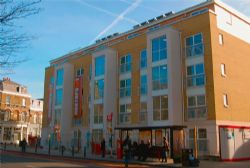While the Feed-in Tariff has been grabbing all the headlines, the Government has quietly launched a similar cash-back scheme for solar heating in commercial applications, but where are the best opportunities? Stuart Elmes has some answers
At the end of 2011 photovoltaic solar energy was hardly out of the news, with legal challenges to the Government's management of the Feed-in Tariff and a dash to install before tariff levels dropped. Among all of this, it would have been easy to miss the fact that the Government has launched a similar cash-back scheme for renewable heat technologies, including solar thermal.
Launched in November 2011, the Renewable Heat Incentive (RHI) is aimed at all buildings with installations of solar heating with the exception of single domestic premises. It pays the owner of the solar system 8.5 pence per kilowatt-hour (kWh) of heat generated, with the tariff index-linked for the
duration of the scheme. The owner can claim the cash-back every quarter for 20 years from the date of registration.
Eligible buildings include commercial properties or groups of houses or apartments served by a single communal solar system. Single domestic buildings are intended to come under the scheme during summer 2013, with a consultation expected this September.
Opportunities for solar thermalAny building that has a need for hot water is an opportunity for solar thermal, but some are more attractive than others. These include:
Residential - Accommodation for students at universities, junior staff at hospitals and pupils at boarding schools often have a centralised plant room where water is heated for distribution around the building. It can be relatively straightforward to install a solar buffer tank to pre-heat the water for the existing heating system.
Sheltered accommodation and Extracare buildings are often heated in the same way, and if residents are assisted to bathe during the working day, then a smaller solar buffer tank can be used.
Apartment blocks can pose a more difficult challenge to the integration of solar water heating, especially if each apartment has its own individual heating system.
However solar heating systems which generate heat from a communal solar array and distribute it to individual apartments via a ring are possible.

An Extra Care building for Hanover, a specialist provider of retirement houising and related services

An apartment block with communal solar system in Northpoint, Islington

Richard's Close in Harrow is a new development comprising of two accomodation blocks built by Mansell Construction with m&e by Scomac Services
Leisure - Hotels often have a high water demand, and if the occupancy of holiday accommodation is seasonally biased towards the summer months, then the effectiveness of a solar system can be higher due to supply matching demand.
Swimming pools are an excellent application for solar heating because the low demand temperature means the solar panels work at maximum efficiency. Coupled to this, the large thermal capacity of the pool allows the full use of energy on sunny days, where storage capacity might limit the energy collection for a domestic hot water system.
Healthcare - Hospitals and surgeries can have a high demand for hot water.
Industrial process heat - an untapped opportunity?
An EU research programme, So-Pro (http://www.solar-process-heat.eu/), identifies an enormous potential for using solar in industrial applications. Many national markets across the EU boast levels of solar thermal deployment for residential buildings that leaves the UK far behind, but when it comes to industrial applications, we're all absolute beginners.
The UK's Renewable Heat Incentive is the first scheme of its kind in the world and could act as a real driver for businesses that use heat in their industrial processes to consider using solar thermal to reduce their dependence on fossil fuel energy, save on bills and get cash-back from the government for doing so.
So-Pro estimates that 30 per cent of total industrial heat demand is at temperatures below 100 deg C and may therefore be suitable for solar heating. The programme highlights a number of case studies where solar energy was successfully deployed in an industrial setting. For example:
Food industry - A producer of dried meat in Jerez de los Caballeros, Spain, installed a 250 sq m solar thermal array to heat 30,000 litres of hot water storage for washing processes in production, and for cleaning vessels and machinery.
Metal processing - An electroplating company in Rahden, Germany installed a 220 sq m solar array to support the heating of the galvanising baths to 80 deg C.
Drying - A brewery in Neumarkt, Germany installed a 72 sq m solar array to pre-heat air for drying processes in the malt house.
The successful implementation of these bespoke renewable energy installations required close co-operation between m&e contractors with a detailed understanding of their customers' heating processes, and technically competent solar suppliers or installers.
With the advent of the Renewable Heat Incentive, the stage is set for heating companies to help their customers cost-effectively to reduce fossil fuel use in a wide range of commercial heating applications.
// The author is chief executive of Viridian Solar and chair of the Thermal Working Group of the Solar Trade Association //